In 2010 BMW Motorrad managed to build strength in a catastrophic retail environment, selling 98,000 units—an increase of 12 percent over ’09. In fact, the company has been steadily gaining momentum since the launch of the magical R1200GS in ’04, making Midas-touch improvements to its top sellers while successfully reeling in new, younger buyers with flashy lures like the sexy S1000RR superbike.
So when Director and CEO Hendrik von Kuenheim told the bleary-eyed, jet-lagged moto-journalists gathered outside of Cape Town, South Africa, that the company’s latest achievement—“a dynamic super-touring bike” with “impressive thrust”—had exceeded every expectation the design and engineering teams had for it, we were inclined to believe him.
Remarkably, our lofty expectations were not nearly high enough. Once aboard the K1600GT and GTL, we were completely and collectively blown away.
Though we spent one full day riding each of the new touring bikes, we’ll concentrate on the sportier K1600GT version (which is the platform for the GTL luxury-tourer discussed in the sidebar) here. It’s also the model I predict will have universal appeal, even in the U.S. where our vast, open highways create long-distance touring opportunities that warrant more comfort-oriented machines.
There’s nothing diminutive about the K1600GT’s physical proportions or its claimed 703-lb. curb weight, but once you get the bike off its sidestand and on the road, it feels hundreds of pounds lighter. True, it’s a common feat of modern engineering to have a bike’s mass melt away using the spell of gyroscopic procession, but it’s an entirely different matter to have the mass of a heavyweight bike not come smashing back into your consciousness as soon as the slightest thing goes awry. Say, when a baboon jumps into the road mid-corner...
Except for the baboons loitering alongside the road and that pesky, left-side-of-the-road driving business, riding in South Africa isn't much different from the U.S. The pavement is generally smooth, corner camber and radius are usually predictable, and car drivers are occasionally skillful. Lucky for us, the motorcycle never got in our way. Even at low speeds, the GT is effortless to control, an asset tested countless times during our photo sessions, which required multiple U-turns on loose, gravel shoulders.
The GT’s extreme manageability at low speeds is a direct result of its low center of gravity. The compact six-cylinder engine uses a dry-sump lubrication system to allow it to sit very low in the chassis. But even more importantly, the engine’s torquey nature and the silky E-gas throttle response make it almost impossible not to pilot in a way that Keith Code would be proud of. Give the throttle a hearty whack, however, and get ready for a thrill: The inline-six puts down a claimed 160 horsepower. Impressive thrust, indeed!
The new, 24-valve six is impressive in more ways than its power output. As Peter de Waal, Vice President of BMW North America, put it, “BMW has a fascination with the inline-six, and with good reason. It has a unique combination of smoothness, endless torque and gorgeous sound that make it hard to resist.” He attributes the fact that engineers were able to create a six-banger with roughly the same dimensions as the four found in the now discontinued K1300GT to the experience gained by building the S1000RR: “Building an engine like this is easier said than done. Only in building the superbike did we learn about space packaging; about designing something so powerful, yet so compact.”
The constant torque, huge top-end power and the flawless functionality of the fueling are only part of what makes the K1600GT so remarkably well balanced. Chassis setup is extremely adaptable via the ESA II system, which allows the rider to select from predetermined suspension settings with the push of a button. Easy-to-reach buttons also let the rider choose between Dynamic Traction Control settings to tune power delivery to road conditions.
All of our riding in South Africa was on dry pavement, but the road conditions varied between smooth and rough, straight and twisty, allowing for exploration of the chassis-control devices as well as the ABS response. There was not much I could do to upset the GT. Even during my most aggressive romps the bike remained unflappable, which is a wonderful quality to have in a fast, heavy motorcycle capable of generating a tremendous amount of speed in a short amount of time. Supersport-tourers are usually fun until you have to slow down or change direction in a hurry. The GT, to the contrary, is as easy to gather up as it is to get going.
Electronics on these bikes are comprehensive. In addition to the mode selectors, the Multi-Controller integrates every bell and whistle you could desire on a motorcycle, and then some. The navigation and audio systems are both state-of-the-art, representing BMW’s commitment to a new generation of rider. “These things are not deemed luxuries anymore,” says de Waal of the bike’s electronics package, which includes Bluetooth capabilities. “We felt we should cater to that, and that’s why there is this wonderful integration between the rider and the passenger and the motorcycle.”
After two days of spinning through the Multi-Controller, sampling everything from Beck on the iPod to the variable-temperature heated seat, the system revealed itself to be more intuitive than conventional touring-bike setups. The only thing that’s lacking is the bike’s onboard speaker system, which could use more volume and clarity.
The GT comes with an amazing list of features for its $20,900 asking price. Anti-lock brakes, heated seat and grips and a Xenon headlight with dynamic leveling that keeps it parallel to the ground during hard braking and acceleration are just a few of the included perks. As an option you can add the adaptive headlight feature, which also tracks through the corners.
Comfort-wise, the K1600GT is very plush, even by sport-touring standards. The seat is not as pleasant as that on the GTL, but the ergonomic arrangement is agreeable for a connect-the-twisties type of tour. Also in keeping with a more dynamic riding style, the GT’s electronically adjustable windscreen is shorter and narrower. This will be preferred by those of average height who will look through the top edge of the GTL’s taller windshield at its lowest setting, and through the screen itself when raised.
The K1600GT, with its spectacular inline-six, is about to redefine our expectations for sport-tourers, just as the GTL is poised to rock the world of luxury bikes.
All I can say after two days on these new motorcycles is: Game on!
Luxury, Redefined
Despite the fact that the "L" in the new K1600GTL's moniker stands for "luxury," BMW engineers flinch if you mention the Honda Gold Wing while discussing their new tourer. Why? Well, they are a little snobbish about the capabilities of their new K1600s, perhaps rightfully so. In fact, if it weren't for the American market pining for a K1200LT replacement, there wouldn't even be a GTL version.
But boy-oh-boy is the GTL grand! It’s far sportier and lighter than its LT predecessor, and despite what the BMW folks say, GL1800 types are going to be drawn like moths to the flame. And why not? It’s very, very comfortable, laden with gadgetry, and it’s lighter and easier to ride than any of the current luxury-tourers on the market. Add in a base price of $23,200 (the same as the new Gold Wing) that includes everything from ABS to heated grips, and it’s a decent deal, too.
On the performance side, the biggest difference between the GT and GTL is chassis setup. The sliding scale of suspension settings departs from a different basis, slanting the GTL’s range toward comfort. Extra amenities on this luxury-tourer include a standard Bluetooth audio system with Sirius satellite radio and iPod connectivity, sculpted touring saddle, locking top case and a taller, wider windscreen. Aesthetically, the GTL comes with more chrome doo-dads and is available in Royal Blue Metallic and Mineral Silver Metallic.
**tech SPEC
BMW K1600GT
**
EVOLUTION
Add two cylinders to the K1300GT, include every feature imaginable, and use the result as the basis for sport- and luxury-tourers.
RIVALS
Honda VFR1200F, Kawasaki Concours 14, Triumph Sprint GT, Yamaha FJR1300.
TECH
Price: $20,900
Engine type: l-c inline-six
Valve train: DOHC, 24v
Displacement: 1649cc
Bore x stroke: 72.0 x 67.5mm
Compression: 12.2:1
Fuel system: BMS-X EFI
Clutch: Wet, multi-plate
Transmission: 6-speed
Claimed horsepower: 160 bhp @ 7750 rpm
Claimed torque: 129 lb.-ft @ 5250 rpm
Frame: Aluminum bridge-type frame with single-sided aluminum swingarm
Front suspension: Duolever with ESA II
Rear suspension: Paralever with ESA II
Front brake: Dual BMW four-piston calipers, 320mm discs with part-integral ABS
Rear brake: Two-piston BMW caliper, 320mm disc with part-integral ABS
Front tire: 120/70ZR-17 Metzeler Roadtec Z8 Interact
Rear tire: 190/55ZR-17 Metzeler Roadtec Z8 Interact
Rake/trail: 27.8°/4.2 in.
Seat height: 31.9/32.7 in.
Wheelbase: 63.7 in.
Fuel capacity: 6.3 gal.
Claimed curb weight: 703 lbs.
Colors: Vermillion Red, Light Grey Metallic
Available: Now
Warranty: 36 mo., 36,000 mi.
Contact: BMW Motorrad USA
P.O. Box 1227
Westwood, NJ 07675
800.831.1117
www.bmwmotorcycles.com
VERDICT 5 out of 5 stars
Puts the sinnlichkeit in sport-touring










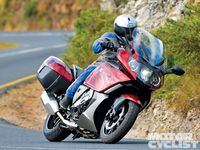

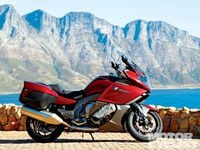


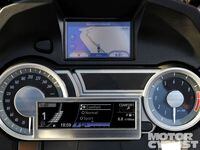
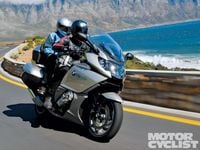
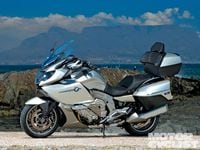
/cloudfront-us-east-1.images.arcpublishing.com/octane/GTCXACQGJ5HAPDTGWUQKDEH44E.jpg)
/cloudfront-us-east-1.images.arcpublishing.com/octane/S35YGSEMEZB4BLTDJTSZPF4GLA.jpg)
/cloudfront-us-east-1.images.arcpublishing.com/octane/5UOT6HPX2JFMRJAX6EH45AR4MQ.jpg)
/cloudfront-us-east-1.images.arcpublishing.com/octane/OKWOJWAKP5EP3OACCRRWPCIX2Q.jpg)
/cloudfront-us-east-1.images.arcpublishing.com/octane/2WF3SCE3NFBQXLDNJM7KMXA45E.jpg)
/cloudfront-us-east-1.images.arcpublishing.com/octane/G4MG6OUCJNBSHIS2MVVOTPX65E.jpg)
/cloudfront-us-east-1.images.arcpublishing.com/octane/IIGGWFOTOJGB7DB6DGBXCCMTDY.jpg)
/cloudfront-us-east-1.images.arcpublishing.com/octane/QSTCM6AVEZA5JJBUXNIQ3DSOF4.jpg)
/cloudfront-us-east-1.images.arcpublishing.com/octane/U4I7G625B5DMLF2DVIJDFZVV6M.jpg)
/cloudfront-us-east-1.images.arcpublishing.com/octane/B6XD6LS6IVCQPIU6HXDJSM3FHY.jpg)
/cloudfront-us-east-1.images.arcpublishing.com/octane/ICL63FEDDRDTTMINYICCEYGMDA.jpg)
/cloudfront-us-east-1.images.arcpublishing.com/octane/FCGZHQXRBZFLBAPC5SDIQLVF4I.jpg)
/cloudfront-us-east-1.images.arcpublishing.com/octane/WNOB6LDOIFFHJKPSVIWDYUGOPM.jpg)

/cloudfront-us-east-1.images.arcpublishing.com/octane/X33NU3E525ECRHXLNUJN2FTRKI.jpg)
/cloudfront-us-east-1.images.arcpublishing.com/octane/6KKT5NNL2JAVBOXMZYS5ZO76YA.jpg)
/cloudfront-us-east-1.images.arcpublishing.com/octane/J5RKG5O455GMPGQRF2OG6LRT7A.jpg)
/cloudfront-us-east-1.images.arcpublishing.com/octane/GX2CIZKQVRH2TATDM26KFG2DAE.jpg)
/cloudfront-us-east-1.images.arcpublishing.com/octane/ZWIDYSAKQZHD5BHREMQILXJCGM.jpg)
/cloudfront-us-east-1.images.arcpublishing.com/octane/CYUHJZCTSJCH3MRAQEIKXK7SCQ.jpg)
/cloudfront-us-east-1.images.arcpublishing.com/octane/LKOFINY56FCXJCANJ5M7ZDQUBY.jpg)
/cloudfront-us-east-1.images.arcpublishing.com/octane/4NBPDACMWJH63JQYJVK3QRBDZI.jpg)
/cloudfront-us-east-1.images.arcpublishing.com/octane/KKHQHRR3FJGX7H2IPU6RALMWG4.jpg)
